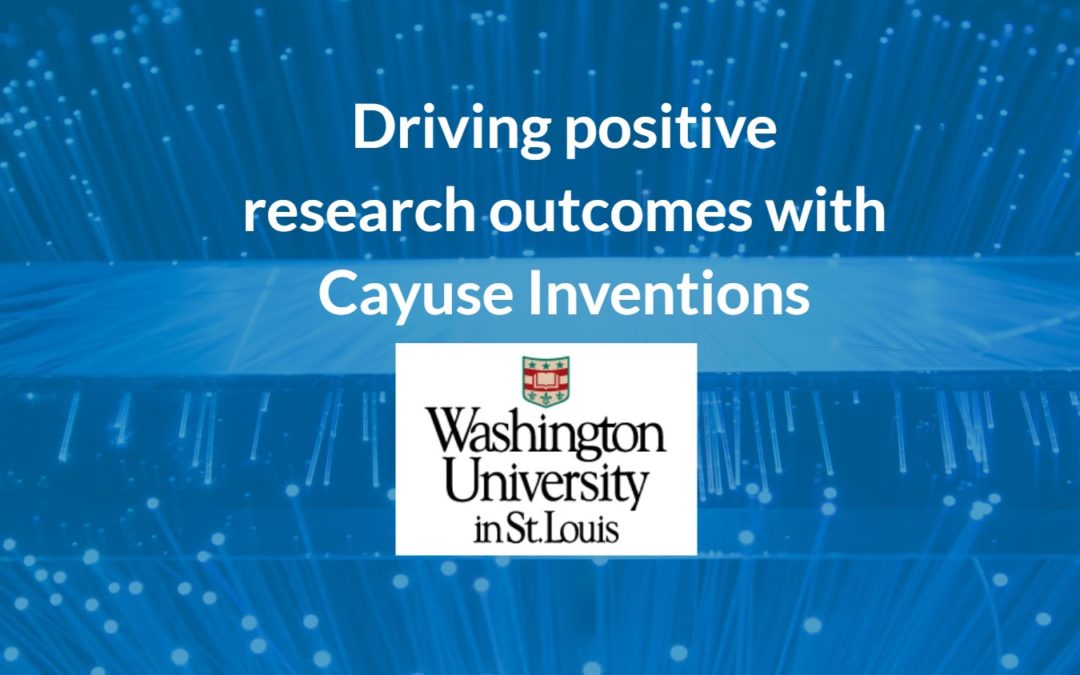Just sat down with Rob Reardon, Assistant Director of Operations at Washington University in St. Louis to talk about tech transfer and how Cayuse Inventions is helping to further develop a culture of innovation at the university. Ultimately, this is one of several Cayuse apps driving positive research outcomes, in this case by managing the tech transfer and commercialization lab-to-market process.
A bit of background: Cayuse Inventions was originally developed in 2011 by the tech transfer professionals at The Ohio State University (OSU), and perfected by Innovate IP, who recently merged with Cayuse, and it’s customers that includes top institutions like Duke University and Washington University in St. Louis.
The “soup to nuts” of tech transfer is a fairly complex process involving many many stakeholders and stages to take an idea through the research process to disclosure, evaluation, managing the IP, marketing and licensing the technology to how, where and when it becomes a life-changing innovation ready to share with the world.
Check out my interview with Rob on tech transfer, and if you don’t have time to watch the 11-minute video, read on for the recap below.
Talk about your experience with tech transfer and some of the major challenges inherent in the tech transfer process?
Tech transfer, from the university perspective, has changed a lot over the last seven to eight years. Earlier, the expectation for universities was a focus on accepting the inventions discovered in the university and identifying the appropriate patent protections and licensing. Today, the expectation goes beyond that. Now there’s pressure to answer the questions of how do we develop a culture of innovation at the university? How do we encourage faculty to launch startups? How do we measure the economic impact of what we’re doing in terms of jobs and social benefits? We still have the existing responsibilities around patent administration and licensing, but now there’s this additional layer. With this kind of evolution in expectations and a more business orientation to commercializing research, it’s crucial to have tools that help support a more complex process.
Given the elevated expectations on universities now, what are some of your goals relative to tech transfer?
In the past we focused on efficiency and streamlining, and this is what led us to Cayuse and the tools Cayuse offers, such as Inventions. Now that we have implemented Inventions and realized increased efficiencies, we’re able expand our focus to the fundamentals of how we develop higher quality IP in the university and how we promote that spirit of innovation while ensuring that the startups we launch are solid.
So, in the past it was more difficult to bring products to market, but with the advent of new tools you are now more able to focus on the quality of the end result.
Yes, now we can focus on the things that matter. Having the operational efficiency is great and it means we can take things to the next level. It’s changed a lot because the access to those apps has led us to new processes.
Cayuse Inventions has a new reporting functionality, I’m wondering if you’re finding that beneficial in terms of improving communications?
Communication is certainly important. We were looking for a tool that would help us provide greater access to PIs and department leaders throughout the university and Inventions supports that. We want people to have an at-a-glance understanding of where their portfolios are and what stage in the process things are at.
Maybe it’s stating the obvious, but sounds like you can say visibility and transparency are two positive effects of better tools?
Yes. I think the way the data is structured in the tool allows us to more easily extract it out of the system to help us make meaningful decisions. You don’t want the heavy push to be in the data collection—you want that to be a click of a button for a data export so you can spend your time on the analysis and decision making. My job involves analysis and Inventions has benefited me tremendously—when all of that up-front work becomes more streamlined.
We’ve actually reduced the staffing size of our accounting team and that’s allowed us to redeploy those folks to different areas, such as marketing. It’s fantastic to have the headcount to be able to make those changes without needing to go to the university and ask for funds for additional headcount—that has been a real win for us.
Are there other areas where you are looking to drive more value from Inventions?
We want to achieve university-wide access and increase focus on marketing. We’re using the marketing functionality quite a bit now. The tool is working really well for us so there’s not a ton more that we’re looking to get out of it at this point. Now, we’re more focused on using the info from the tool to make better decisions. We’ve recently implemented the legal portal. When our law firms submitted invoices in the old way they’d send us their files, and we had to upload them into our system and link them to patent records and there was a lot of back and forth and headaches. So now our legal teams can import files themselves and save both sides time and a ton of administrative work.
Also, we’re now using the distribution module that calculates how income is distributed throughout the university. Our previous system wasn’t great but now with Inventions we’ve seen some real time savings.


